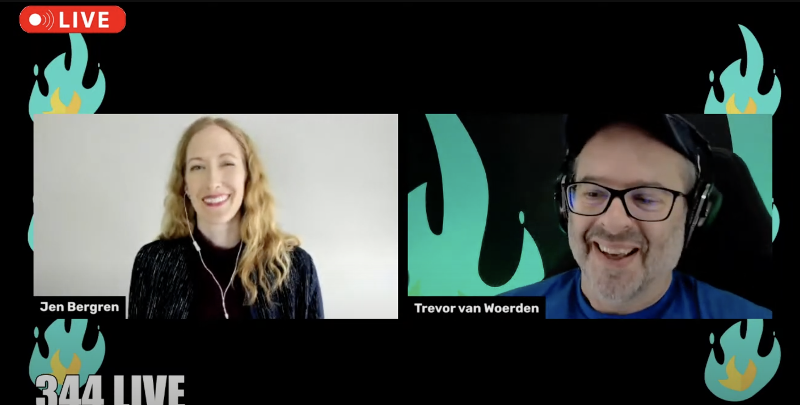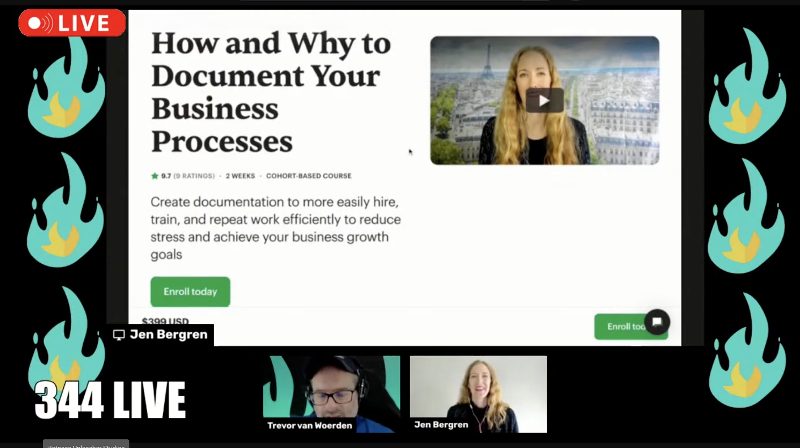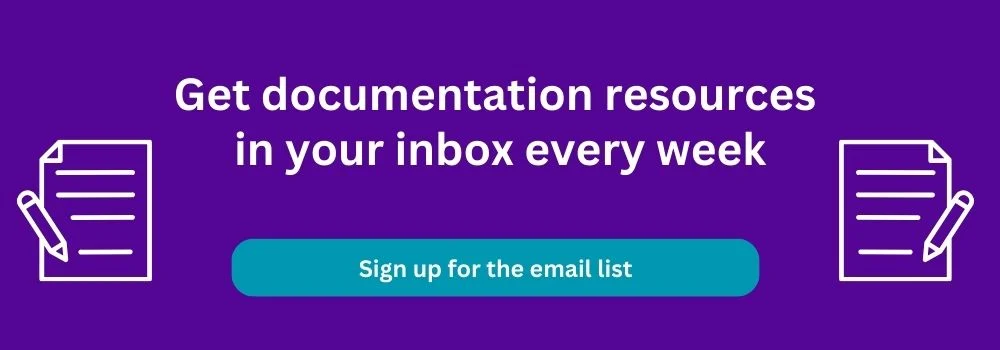Thank you to Trevor van Woerden for inviting me to the 3:44 show to talk about documenting your business processes! Thank you to Leslie Greenwood of Chief Evangelist Consulting for recommending me!
The 3:44 show broadcasts live at 3:44 pm Pacific time on YouTube and LinkedIn Live for about 15 minutes, and provides entrepreneurs a safe space and opportunity to talk about their solutions. It also highlights a job seeker at the beginning of each episode.
The show covers these questions:
1. Describe the pain or aspiration (aka the need) your ideal customer has
2. Detail your backstory and legitimacy
3. Show how your solution works
4. Explain how your solution is different from others
5. Extoll the expected outcomes after purchase
6. Lay out the steps to implement
7. Provide a takeaway tip
Trevor began the show by talking about how we were like oil and water since he likes to "fly by the seat of his pants." He did take my course after the show, so I hope he is experiencing some of the documentation benefits we spoke about! 😀
You can read the notes or watch the video.
The notes I prepared in advance of the show, so the content is somewhat different, though I listened to the show to add in any important details given live.
Describe the pain or aspiration (aka the need) your ideal customer has
My class is about documenting business processes, and in simple terms, that means instructions for how to do the work. A lack of business process documentation prevents your company from scaling and creates a gap in talent management.
Trevor asked who has signed up for the class, how would I describe those people?
A lot of my customers are early-stage companies that need to grow, or ones that need to gain efficiency. Maybe their team is not as big as they would like at the moment, as a result of a reduction in team size. Speaking of reducing team sizes, right now, a relevant pain is you or your team is suddenly having to do more (jobs) with less (people) and finding it difficult to remember how to do every task for the 100 hats you wear…
Trevor pointed out that could be two different kinds of companies, companies growing and companies shrinking, which is a correct observation! Though it may be more urgent for companies in growth mode, documentation can help all companies with pains such as:
- You're thinking of hiring and training new people soon, to relieve your own stressful workload, start delegating…
- And not looking forward to 100 phone calls with that new person daily since all the information they need lives inside your head, the only way other people can currently access that info is by asking you
- You're tired of everyone in the company or the team spending their time reinventing the wheel every time they do a task or process, with variable and unpredictable results…
- You need to improve your processes to improve the business, but every person is currently doing everything differently, so there is no way to know what to improve…
Documentation can help!
But because it is rarely urgent, it’s a responsibility that is ongoing forever, so it often gets overlooked and procrastinated. People never end up doing it, even if they understand the benefits.
Maybe starting it is overwhelming, maybe keeping it up to date seems overwhelming, so they don’t even start.
That is where my class comes in, to help get people started on their documentation journey in a manageable way, and to make progress toward their goals.
If you're wondering...What is documentation? Check out this blog.
Who can documentation help? Within those organizations?
Documentation can be useful for any person in any role, but this course may be most relevant for:
For smaller companies, maybe under 100 people (I haven't nailed down these company size recommendations yet):
- The founder, CEO, or founding team member who wants to easily train others to efficiently take over their work and run it reliably
- A founder making their first hire, or a first hire of a department, trying to prioritize what to do first and what to delegate
- A new team leader trying to help their team improve their processes, efficiency, remove stress from the team, and hit department goals
- Operationally-minded team members who are tired of being tactical and reactive instead of strategic and proactive – people who want to spend more time thinking about their big new projects, not spend as much time answering questions about processes or remembering how to do that routine repeated work.
Trevor asked if I'm targeting any company verticals, like service model businesses. I'm still learning about the ideal customers but so far, it's been a lot of tech companies and agencies since that is a lot of my network. Also, remote work companies can especially benefit from documentation.

Detail your backstory and legitimacy
I've been creating documentation for almost every job before I knew it was called documentation.
Writing down how to do the steps to do the work. Relieving my memory, preventing errors, improving processes, and showing the work I'm doing. Helping to train people to take over for me when I left those roles for the past 20 years.More recently, I was employee number one-ish, at a HubSpot RevOps and WebOps agency called Remotish. I would build documentation so I didn’t have to remember the 100 different things I was doing every day, and so we could run the processes the same way each time in order to see and improve different steps.
As the company grew, we could use the documentation to create new roles, job descriptions, and train them to run and/or own those processes and the documentation for it (knowledge management).
One year, we needed to hire a lot of people very quickly to grow from 10-20 people, so I used the documentation to create an extensive onboarding program to help train new people faster. It provided self-service asynchronous support
I got a lot of great feedback about how no other company our size had a good (or any) onboarding or documentation, and how it made people feel supported and made them feel like part of the team and culture, to be more successful sooner.
Creating the onboarding and knowledge management made me want to learn about making courses to help people learn, so I took an instructional design certification. Then I signed up for an accelerated class from a live cohort course platform called Maven, to learn about cohort courses. They targeted me really well. Surprisingly to me, I actually decided to make a course at that point and not just learn about making them. I was assisting with a HubSpot Academy live cohort bootcamp at the time so I had some idea of how a live course worked.
I chose to make the course about documentation because it was a topic I had been talking about for a year, doing speaking events and writing articles, so I had tested some content and knew there was a gap in the market there. People are unable to find good resources about it.
I created an interest survey to gather data about what people wanted in a course, used it to make the course in the fall of 2022, ran a beta cohort in December, and ran it a few more times since then. At the time of recording, I was getting ready to run the fourth cohort of the course.
Trevor enjoyed the 'one-ish' employee designation and how we used documentation to keep carving out new jobs, and carving off responsibilities. He mentioned it was a good proof point that I had actually done this work, similar to if he wanted to make a course about how to make a show, then he had better have some shows completed.
Show how your solution works
I've been getting a lot of good feedback from sending a lot of surveys to course members, and I make improvements based on customer feedback between cohorts.
Trevor pointed out that he wasn't surprised since the surveys and improvement are another form of documentation, and also having the process to send the surveys is documented so I don't forget to gather feedback!
I also split off the two most popular topics in the course into individual one-session workshops.
(Find all the courses here.)
The main cohort-style course contains:
- Four 90-minute sessions - each session alternates between lecture/presentation, individual work time, breakout discussion, full group discussion (two of the sessions may extend to 2 hours in 2024 to allow for more work time and breakout time)
- 1 hour office hours if they want to ask questions outside of class
- A community forum (Slack-like component)
- Workbook templates to walk them through the topics to complete work relevant for their own business, pre-work, in-class work, work between sessions we discuss during class
- The four session topics are:
- Determine which processes to start documenting first
- Write a clear process anyone can follow (you can also read a blog on this topic)
- Create a system to keep documentation in use and updated
- Construct a compelling case to convince your team why documentation is essential for success (overcoming objections, building it into culture)
Trevor had a great question about if he signs up for the class will he be interacting with the other course members. The answer is yes! You'll be interacting during discussions and breakouts in class and also in the Maven community (like Slack) between sessions.

Explain how your solution is different from others
The only documentation classes I have seen so far are more for technical documentation, software/product/coding type of documentation. Not this kind of process documentation, which is instructions plus other context about doing the work across many departments.
Because documentation is an ongoing habit, it can be really difficult to start the habit, then keep it going, AND convince other people to join you, so that is why a lot of this course is about the human elements of the work: prioritization, communication, time and project management...Those are the biggest blockers for people to start to create, use, and update documentation.
Those blockers are also one of the reasons I started sharing the knowledge with a live course, not a book about documentation or a recorded course that you buy and never watch or use.
Note that since this show was recorded, I've also released an on-demand version of the course for other benefits.
A live course has accountability for showing up and not only learning but also doing, along with learning what other people are doing to solve similar problems. There is a workbook and individual work time set aside during class and discussions. So people are more likely to make progress and finish actual documentation work as a result of taking the class.
Trevor asked if the course is similar to other Maven courses. The format is pretty similar to a lot of Maven courses since it was taught in their accelerator, the switching between the different activities during each class to keep people's attention, making sure I'm not talking the whole 90 minutes.
Extoll the expected outcomes after purchase
If they show up to class, or watch the recording of the live class (life happens) and do the assignments, then
the direct outcomes, the tactical things they walk away with include:
- They will know the first 10 priority pieces of documentation they need to create - getting started, removing overwhelm
- They will have finished 1-2 pieces of documentation
- They will have started planning out the system for time management, project management, communication, roles and responsibilities, documentation storage tools; all the system needs
- They will be prepared to face objections from leaders and team members. Documentation is not yet a normal behavior for most companies, so it needs change management, and change of any kind can cause objections
- They will have a template of their ideas they can use to start to create a culture of documentation to spread their efforts throughout the company, to keep this momentum going and not have all the weight of responsibility of documentation on their shoulders forever
The bigger picture outcomes include:
- Less stress – they don’t have to rely on memory to do their work, they can delegate more of it. Less brain drain, less decision fatigue.
- Better onboarding experience for new hires, which results in better retention and culture. Regular documentation fosters a culture of open communication, collaboration, visibility, transparency, learning, helping…signs of a healthy culture where people want to work
- Documented processes can be run more efficiently and produce faster, better results to meet business goals (resulting in promotions and more)
- Fewer meetings - people don’t need to meet to extract info from other people’s heads. It’s documented. (Trevor mentioned he's not sure he can ever get enough meetings... we have different work styles 😅 )
- Efficiency in general - working fewer hours, with better, predictable results
- Takes less time to do the routine, repeated tasks
- You don’t have to use brainpower to invent a new way of doing things every time. All that needless recreating of the wheel can be exhausting and cause decision fatigue
- You can save that creative brainpower for an exciting new project where you actually do need to build from scratch
Trevor liked that the course was live so he knew it wasn't something from 6 years ago, something out-of-date, and he liked that I am actually there in class and accessible to people.
Lay out the steps to implement
- Enroll in the course – https://maven.com/jen-bergren/documentation1
- To be the most successful and see the most benefits: Do the prep work before the first course
- Show up to sessions and be ready to do the work and discuss!
- Do the assignments between class
- After class, continue to put what you started into place and expand your efforts after class
Provide a takeaway tip
(I condensed the messy notes below into a 60-second version here, focusing on the advice to 'use the tool easiest for you,' when starting documentation)
Because tools/tech/software are what a lot of people like to talk about online, a lot of people have shiny object syndrome.
They think a new tool will solve all their problems, if they just buy it, it will magically do everything. Sadly, that is not true.
So my takeaway is:
If you are in the first stage of creating documentation, version 1.0, starting from scratch – use the tool easiest for you. Something you are already using.
Now is not the time to learn a new tool, because the habit of creating, using, and updating is more important than the tool, especially in the early stages of the work.
Remember that though you can hire someone later to migrate your documentation from one system to another, it is very difficult to hire someone to write your processes for you, to extract that information from your brain about how things work in your job in your company. It's possible, but time-consuming for you and expensive (paying for the consultant’s time to sit with you on calls).
Write version 1 of the documentation first before you get distracted by tool research and testing. The tool is not going to write the documentation for you (though there are screen recording tools and other tips on how to help get started and remove that fear of the blank page when writing.) Write it first.
Even throwing it in a Google doc that is shared, and that people know where to find it, that is better than the info only living in your head.
Start small is the theme throughout the class!
One more tip to build onto that:
When expanding your documentation efforts to more people than just yourself, my #1 tip is to use a tool your team is already using daily so you don't have to teach them a new tool IN ADDITION to teaching them new habits about creating, using, and updating documentation. Tool adoption is difficult!Consider:
- First: What is the team’s current “Home base” for their work? Where do they currently spend most of their day?
- Can you use that tool for documentation or integrate into it?
If you already have a documentation storage or knowledge management tool but people aren’t using it:
- It may not be the tool’s fault
- Switching to a new tool may not solve the problem
- Plus then you have to deal with tool adoption issues.
- Find the root cause of the issue by doing user research, auditing your communication cadence about documentation, roles and responsibilities, rewards, project & time management, all the other parts of the system first before blaming the tool on its own.
Thank you, Trevor, for this interview and for taking my course! Subscribe to his YouTube channel!
Learn more about how to document business processes in this guide!
Topics: Documentation, Event



